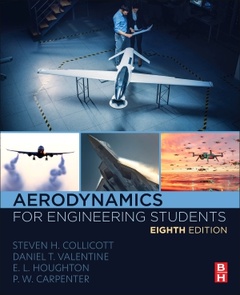Description
Aerodynamics for Engineering Students (8th Ed.)
Authors: Collicott Steven H., Valentine Daniel T., Houghton E. L., Carpenter P. W.
Language: English
Subjects for Aerodynamics for Engineering Students:
115.88 €
Not Yet Published
Add to cart804 p. · 19x23.3 cm · Paperback
Description
/li>Contents
/li>Biography
/li>Comment
/li>
Aerodynamics for Engineering Students, Eight Edition, is one of the world?s leading course texts on aerodynamics. It provides concise explanations of basic concepts, combined with an excellent introduction to aerodynamic theory. This updated edition has been revised with improved pedagogy and reorganized content to facilitate student learning and includes new examples in many chapters, expanded use of the "aerodynamics around us" boxes to help put the content into proper context for students, and more coverage and use of computational methods like MATLAB.
PART I: INTRODUCTION 1. Basic Concepts and Definitions PART II: FUNDAMENTALS OF FLUID MECHANICS 2. Equations of Motion 3. Viscous Boundary Layers 4. Compressible Flow PART III: AERODYNAMICS OF WINGS AND BODIES 5. Potential Flow 6. Two-Dimensional Wing Theory 7. Wing Theory 8. Airfoils and Wings in Compressible Flow PART IV: APPLICATIONS OF AERODYNAMICS 9. Computational Fluid Dynamics 10. Flow Control, Planar and Rotating Wing Designs Appendix A. Symbols and Notation B. Properties of Standard Atmosphere C. A Solution of Glauert Type Integrals Appendix D: Conversion of Imperial Units to Syst´eme International (SI) Units
Daniel T. Valentine Ph.D. is Professor Emeritus and was Professor and Chair of the Department of Mechanical and Aeronautical Engineering, Clarkson University, Potsdam, New York. He was also Affiliate Director of the Clarkson Space Grant Program of the New York NASA Space Grant Consortium, a program that provided support for undergraduate and graduate research. His Ph.D. degree is in fluid Mechanics from the Catholic University of America. His BS and MS degrees in mechanical engineering are from Rutgers University. Dr. Valentine is also co-author of Aerodynamics for Engineering Students (Butterworth Heinemann).
- Provides contemporary applications and examples that help students see the link between everyday physical examples of aerodynamics and the application of aerodynamic principles to aerodynamic design
- Contains MATLAB-based computational exercises throughout, giving students practice in using industry-standard computational tools
- Includes examples in SI and Imperial units, reflecting the fact that the aerospace industry uses both systems of units
- The new edition includes improved pedagogy, including more worked examples throughout, re-organization of content, and more integration of MATLAB

